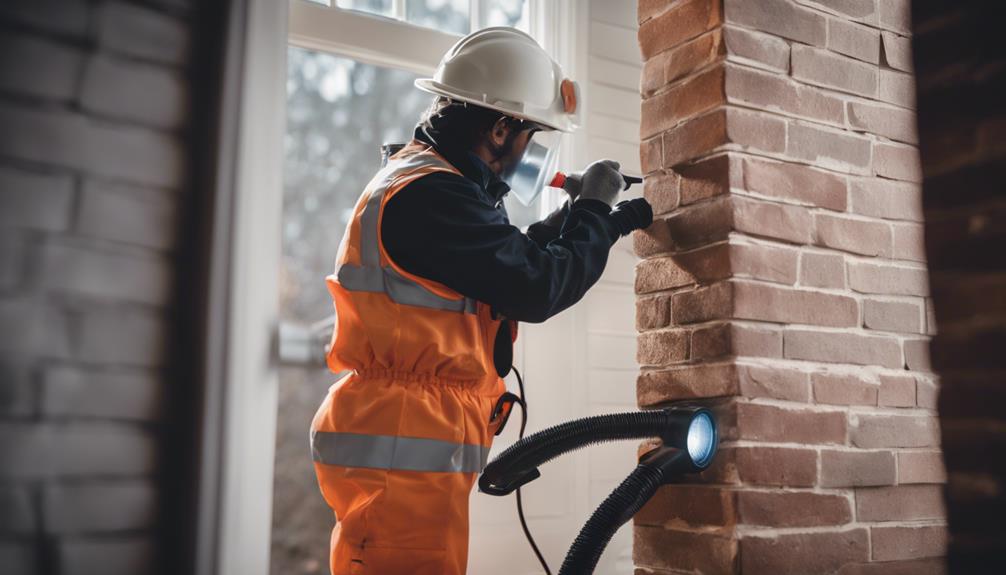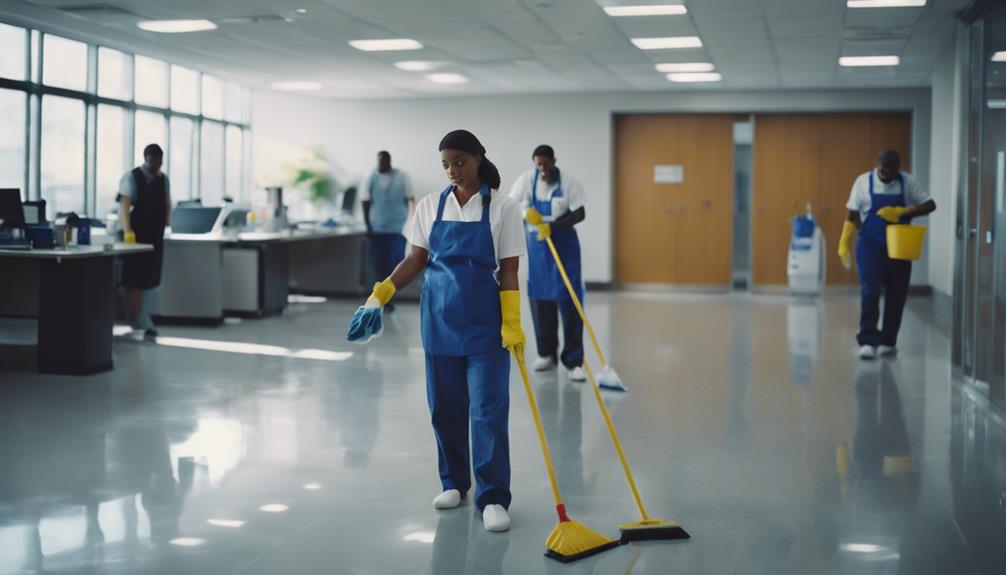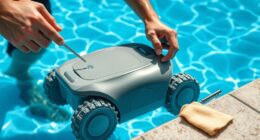To guarantee chimney safety and efficiency, prioritize maintenance. Regular inspections help prevent issues and tackle creosote buildup. Install safety equipment like chimney caps and detectors for added protection. Childproof the fireplace area to minimize risks for your loved ones. Manage ventilation and drafts to enhance performance and safety. Get fire extinguisher training for emergencies. Securely use your fireplace by avoiding flammable liquids. Consider professional chimney services for thorough cleaning and maintenance. Prevent creosote buildup, a leading cause of fires, through proactive care. Essential tips for safety and efficiency await.
Key Takeaways
- Regular chimney cleanings prevent creosote buildup and maintain safety.
- Use seasoned hardwoods at high temperatures to reduce creosote accumulation.
- Install a chimney cap to prevent moisture buildup and enhance efficiency.
- Professional chimney services ensure safety and efficient fireplace performance.
- Address creosote buildup proactively to safeguard your home from chimney fires.
Importance of Chimney Maintenance
Regular chimney maintenance is necessary for maintaining the safety and efficiency of your fireplace and chimney system. By conducting routine inspections and professional evaluations, you can identify potential issues early on, preventing safety hazards like chimney fires and carbon monoxide buildup.
One important aspect of chimney maintenance is addressing creosote buildup, a highly flammable substance that can ignite and cause chimney fires. Neglecting chimney maintenance can lead to costly repairs down the line, making it essential to stay proactive.
Keeping your chimney clean and in good condition not only ensures a secure chimney but also promotes proper airflow, efficient heating, and extends the lifespan of your chimney and fireplace.
Companies like Alliance Inc. in Duluth offer a variety of chimney services, including sweeping, repairs, cap installation, and liner services, making it easier for homeowners to maintain a safe and efficient chimney system.
Safety Equipment Installation

Addressing the safety of your chimney system, the installation of proper safety equipment is vital to minimizing risks and guaranteeing a secure environment for your home.
Here are essential safety equipment installations for maintaining a safe and efficient chimney system:
- Chimney Cap: Installing a chimney cap not only optimizes airflow but also prevents debris from entering the chimney, reducing the risk of blockages and moisture damage.
- Smoke and Carbon Monoxide Detectors: Ensure these detectors are in place to provide early warning signals in case of smoke or carbon monoxide leaks, aiding in poisoning prevention and alerting you to potential dangers.
- Fire Extinguisher: Keep a fire extinguisher nearby and make sure you and your household members know how to use it correctly. In emergencies, a fire extinguisher can be essential for quickly managing small fires and preventing them from escalating.
Childproofing Fireplace Area

When childproofing your fireplace area, prioritize installing gates or barriers to prevent access by children and pets to guarantee household safety. Creating a secure environment around the fireplace is important to prevent accidents and maintain a safe living space. By childproofing the fireplace area, you reduce the risk of fire hazards and potential burns.
Clearing the vicinity of flammable items within a 3-foot radius is also necessary to minimize any dangers. Ensuring that safety measures are in place around the fireplace area not only protects your children and pets but also contributes to a safer overall living space, especially when the fireplace is in use.
Ventilation and Draft Management

You must understand the significance of proper ventilation to keep your chimney operating efficiently and maintain good indoor air quality.
By implementing draft management techniques, you can prevent backdrafts and make sure your chimney performs at its best.
Additionally, addressing draft issues promptly can enhance your chimney's efficiency and reduce the risk of indoor air quality problems.
Proper Ventilation Importance
Proper ventilation in chimneys plays an essential role in ensuring efficient operation and reducing indoor air pollutants. Here are three key points to keep in mind:
- Efficient Operation:
Adequate ventilation allows for proper airflow, which is necessary for the combustion process to work effectively. This not only enhances the performance of your chimney but also helps in reducing energy waste.
- Reducing Indoor Air Pollutants:
Effective ventilation helps in directing harmful gases, like carbon monoxide, out of your home. By ensuring that these pollutants are expelled properly, you create a safer and healthier indoor environment for you and your family.
- Preventing Backdrafts:
Proper ventilation and managing drafts are essential in preventing backdrafts, which can lead to smoke and toxic fumes entering your living space. Maintaining good airflow helps in keeping the chimney working efficiently and reduces safety risks associated with poor ventilation practices.
Draft Efficiency Tips
Optimizing draft efficiency through proper ventilation and draft management is crucial to maintaining a safe and effective chimney operation. To enhance performance, verify proper ventilation by trimming overhanging branches that could obstruct airflow. Address draft issues promptly to prevent backdrafts, which can lead to increased indoor air pollutants. Proper ventilation not only reduces creosote buildup but also enhances overall chimney efficiency.
Monitoring draft is essential for maintaining a steady flow of air through the chimney. By actively overseeing draft, you can prevent issues such as poor combustion and smoke entering your living space. Regularly checking and adjusting the draft will help maximize the efficiency of your chimney and fireplace.
Indoor Air Quality
Maintaining good indoor air quality in your home is directly linked to proper ventilation and efficient draft management in your chimney. To ensure a healthy living environment and efficient chimney performance, consider the following:
- Proper Ventilation:
Adequate airflow in the chimney is essential for preventing the accumulation of harmful gases, such as carbon monoxide, which can pose serious health risks to you and your family.
- Effective Draft Management:
Managing the draft effectively helps the chimney function at its best, reducing the chances of backdrafts that can lead to the release of indoor air pollutants into your home.
- Regular Maintenance:
Trim overhanging branches near the chimney to maintain clear ventilation and improve airflow. Addressing draft issues promptly and keeping the chimney surroundings clean are vital steps to promote proper ventilation and prevent the risk of indoor air pollutants affecting your indoor air quality.
Chimney Odor Awareness

To effectively manage chimney odors, address them promptly to prevent potential issues and maintain a comfortable living space. Chimney odors can be indicative of hidden problems that may compromise safety and the overall maintenance of your chimney.
Ignoring unpleasant chimney odors can lead to a decline in indoor air quality, affecting the health and comfort of your home environment. Regular maintenance is essential in managing and eliminating these odors to guarantee a safe and enjoyable fireplace experience.
By promptly identifying and resolving chimney odors, you can prevent further damage and maintain a healthy indoor environment. Taking proactive steps to address chimney odors not only enhances safety but also contributes to a more pleasant atmosphere in your living space.
Fire Safety Training

You should prioritize establishing an evacuation plan as part of fire safety training.
Knowing how to use a fire extinguisher is essential for your safety.
Understanding proper fireplace usage is key to preventing potential hazards.
Evacuation Plan Establishment
Establishing a clear evacuation plan is an essential step in ensuring household safety during fire emergencies. When it comes to fire safety training, having a well-thought-out evacuation plan can make a significant difference in how effectively you respond to emergencies.
Here are three key aspects to take into account when establishing your evacuation plan:
- Identify Escape Routes: Determine primary and alternative evacuation routes from different areas of your home. Practice using these routes regularly to make sure everyone knows how to reach safety quickly.
- Designate Meeting Points: Choose designated meeting points outside your home where all household members should gather after evacuating. This helps account for everyone and prevents anyone from re-entering a dangerous area.
- Emergency Contact Services: Keep a list of emergency contact numbers readily accessible near phones or saved in your mobile devices. These contacts should include local fire services, medical services, and trusted individuals who can assist during emergencies.
Fire Extinguisher Training
Fire extinguisher training is necessary for equipping household members with the needed skills to effectively operate a fire extinguisher during emergencies.
Understanding the different types of fire extinguishers and their uses is important in efficiently tackling various types of fires that may occur.
Training on the PASS method (Pull, Aim, Squeeze, Sweep) ensures that individuals can effectively use a fire extinguisher when needed.
Regular fire extinguisher inspections and maintenance are crucial to guarantee their functionality in emergencies.
It's important to have a clear evacuation plan in place and understand when to use a fire extinguisher versus when to evacuate to ensure overall fire safety.
Remember to conduct regular inspections and maintenance of your fire extinguishers to keep them in best condition.
Knowing how to operate a fire extinguisher correctly can make a significant difference in containing a fire before it escalates.
Stay prepared and stay safe by prioritizing fire extinguisher training as part of your overall fire safety measures.
Proper Fireplace Usage
Understanding the correct procedures for using a fireplace safely is essential for preventing accidents and ensuring household fire safety.
To practice responsible fireplace usage and enhance fire safety, consider the following:
- Establish an Evacuation Plan: Develop a clear evacuation plan with designated routes to exit your home in case of a fire emergency. Knowing how to leave the premises safely can prevent injuries and save lives during a crisis.
- Learn Fire Extinguisher Usage: Familiarize yourself with the operation of fire extinguishers and keep one in an easily accessible location. Understanding how to effectively use a fire extinguisher can help contain small fires before they escalate.
- Prepare Emergency Procedures: Include steps like contacting emergency services, closing the damper to prevent the spread of fire, and waiting for professional assistance as part of your fire safety training. Being prepared for emergencies can mitigate risks and minimize damage in the event of a fireplace incident.
Flammable Liquids Avoidance

When starting fires in your fireplace, it is essential to steer clear of using flammable liquids like gasoline or lighter fluid to prevent uncontrollable flames and toxic fumes. Not only do flammable liquids pose risks of dangerous flare-ups and compromise indoor air quality, but they can also lead to rapid, unpredictable fires that are challenging to extinguish, potentially causing property damage. To ensure safety and efficiency, opt for safer alternatives like kindling and fire starters for controlled ignition in your fireplace. By following safe burning practices such as using seasoned wood, ensuring proper ventilation, and diligently monitoring fires, you can avoid the dangers associated with flammable liquids while enjoying a cozy fire.
| Flammable Liquids Avoidance | Benefits |
|---|---|
| Avoid using gasoline or lighter fluid | Prevent uncontrollable flames and toxic fumes |
| Choose safer alternatives like kindling and fire starters | Reduce risks of accidents and injuries |
| Practice safe burning techniques with seasoned wood | Minimize property damage and maintain indoor air quality |
Professional Chimney Services

To maximize performance and safety for your chimney, consider investing in professional chimney services provided by certified experts. These professionals offer a range of services to guarantee a safe and efficient fireplace:
- Regular Cleaning: Scheduled professional chimney cleaning helps prevent creosote buildup, a common cause of chimney fires.
- Annual Chimney Inspections: Certified chimney sweeps conduct thorough inspections annually to identify potential issues early on.
- Protect Your Home: By hiring professionals for your chimney care, you can safeguard your home from fire hazards and guarantee the longevity of your chimney.
Creosote Buildup Prevention

Regular chimney cleanings are essential in preventing creosote buildup, a leading cause of chimney fires. Creosote, a highly flammable substance, can accumulate in the chimney from incomplete wood combustion. Over 25,000 chimney fires are reported annually in the US due to creosote buildup, highlighting the importance of regular cleanings for chimney safety.
Efficient operation of your chimney also relies on preventing creosote formation. Burning seasoned hardwoods at high temperatures can help reduce creosote buildup, ensuring a safer and more effective chimney system.
To enhance prevention measures, consider installing a chimney cap to prevent moisture buildup. Moisture can accelerate creosote formation, increasing the risk of chimney fires. By addressing creosote buildup proactively through regular maintenance, you can safeguard your home from potential fire hazards and maintain the efficiency of your chimney.
Frequently Asked Questions
How to Make Sure Your Chimney Is Safe?
To make sure your chimney is safe, schedule annual inspections, clean regularly to prevent creosote buildup, install carbon monoxide detectors, childproof the fireplace area, and monitor ventilation for peak performance. Stay proactive for safety.
What Is the Proper Way to Clean a Chimney?
Start by preparing your fireplace or stove and gather your chimney brush and rods. Sweep top to bottom, inspect the cap, and check for creosote. Wear protective gear, have a partner, and a fire extinguisher handy for safety.
What Precautions Should Be Taken During a Chimney Fire?
During a chimney fire, close the damper to control airflow, use a fire extinguisher for small fires, and evacuate if the fire grows. Never use water as it can spread the fire. Confirm everyone is safe before acting.
How Often Does a Chimney Really Need to Be Cleaned?
You should clean your chimney annually to prevent creosote buildup and potential fires. Heavy use may require more frequent cleanings. Regular maintenance guarantees proper airflow, reduces safety risks, and boosts heating efficiency. Consider hiring professionals for assessment and recommendations.
Conclusion
So there you have it – keeping your chimney clean and safe is a piece of cake!
By following these essential tips, you'll be able to enjoy cozy fires without any worries.
Remember, an ounce of prevention is worth a pound of cure, so don't wait until it's too late to take care of your chimney.
Stay safe and happy chimney cleaning!










